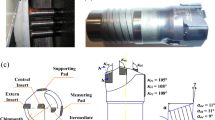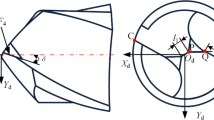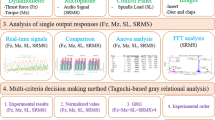Abstract
The radial cutting force balance of an indexable insert drill directly affects the workpiece’s depth, dimensional accuracy, and surface quality. Accurate evaluation of the radial cutting force of the indexable insert drill is necessary to guide for the improvement of the drilling performance. In this research, a new finite element simulation model of radial cutting force for indexable insert drill was proposed considering the influencing regularities of cutting feed, cutting speed, and cutting width on the unit radial cutting force of the drill. The optimal geometric parameters of the indexable insert drill were obtained based on the simulated radial cutting force balance. The accuracy of the new proposed model was verified according to the diameter deviation between the hole and the tool. The difference between the hole diameter and the tool diameter was reduced by 80% for the new proposed model compared to the former radial cutting force model.










Similar content being viewed by others
Data availability
All data generated or analyzed during this study are included in the present article.
References
Davim JP, Monteirobaptista A (2001) Cutting force, tool wear and surface finish in drilling metal matrix composites[J]. Proc Inst Mech Eng Part E: J Process Mech Eng 215(2):177–183
Adarsha Kumar K, Ratnam C, Venkata Rao K et al (2019) Experimental studies of machining parameters on surface roughness, flank wear, cutting forces and work piece vibration in boring of AISI 4340 steels: modelling and optimization approach. SN Appl Sci 1:26. https://doi.org/10.1007/s42452-018-0026-7
Okada M et al (2014) Cutting performance of an indexable insert drill for difficult-to-cut materials under supplied oil mist[J]. Int J Adv Manuf Technol 72(1–4):475–485. https://doi.org/10.1007/s00170-014-5691-0
Liang Z et al (2020) Influence of chisel edge axial rake angle on the drilling performance of helical point micro-drill[J]. Int J Adv Manuf Technol 107:1–13
Yan X, Zhang K, Cheng H et al (2019) Force coefficient prediction for drilling of UD-CFRP based on FEM simulation of orthogonal cutting. Int J Adv Manuf Technol 104:3695–3716. https://doi.org/10.1007/s00170-019-04048-8
Xiao Y et al (2018) Investigation of active vibration drilling using acoustic emission and cutting size analysis[J]. J Rock Mech Geotech Eng 10(2):390–401
de Moura J et al (2021) An empirical model for the drilling performance prediction for roller-cone drill bits[J]. J Petroleum Sci Eng 204:108791
Guo D-M et al (2012) Prediction of the cutting forces generated in the drilling of carbon-fibre-reinforced plastic composites using a twist drill[J]. Proc Inst Mech Eng Part B: J Eng Manuf 226(1):28–42
Chang S, Bone GM (2009) Thrust force model for vibration-assisted drilling of aluminum 6061–T6[J]. Int J Mach Tools Manuf 49(14):1070–1076. https://doi.org/10.1016/j.ijmachtools.2009.07.011
Langella A, Nele L, Maio A (2005) A torque and thrust prediction model for drilling of composite materials[J]. Compos A Appl Sci Manuf 36(1):83–93. https://doi.org/10.1016/j.compositesa.2004.06.024
Okada M, Ueda T, Hosokawa A et al (2012) Drilling of difficult-to-cut materials by using indexable insert drill with non-axisymmetrical geometry[J]. Trans Japan Soc Mech Eng Series C 78(785):252–261. https://doi.org/10.1299/kikaic.78.252
Li C, Duan C, Chang B (2022) Instantaneous cutting force model considering the material structural characteristics and dynamic variations in the entry and exit angles during end milling of the aluminum honeycomb core[J]. Mech Syst Signal Proc 181:109456
Bin Yang et al (2022) Prediction of cutting force and chip formation from the true stress–strain relation using an explicit FEM for polymer machining[J]. Polymers 14(1):189–189
Zhiqiang L et al (2021) Novel micro-deep-hole drill with variable web thickness and flute width[J]. Precision Eng 72:340–355
Babu BH, Rao KV, Ben BS (2021) Modeling and optimization of dead metal zone to reduce cutting forces in micro-milling of hardened AISI D2 steel. J Braz Soc Mech Sci Eng 43:142. https://doi.org/10.1007/s40430-021-02861-5
Parsian A et al (2014) A mechanistic approach to model cutting forces in drilling with indexable inserts[J]. Procedia CIRP 24:74–79
Li Z, Yuan S, Ma J et al (2021) Cutting force and specific energy for rotary ultrasonic drilling based on kinematics analysis of vibration effectiveness[J]. Chinese J Aeronaut 35(1):376–387
An B, Zhang B (2017) Simultaneous selection of predictors and responses for high dimensional multivariate linear regression[J]. Stat Prob Lett 127:173–177
Venkata Rao K, Murthy PBGSN, Vidhu KP (2017) Assignment of weightage to machining characteristics to improve overall performance of machining using GTMA and utility concept[J]. CIRP J Manuf Sci Technol 18:152–158. https://doi.org/10.1016/j.cirpj.2016.12.001
Bao WY, Tansel IN (2000) Modeling micro-end-milling operations. Part I: analytical cutting force model[J]. Int J Machine Tools Manuf 40(15):2155–2173
Funding
The project is supported by the National Key Research and Development Program of China (2019YFB2005401). This work was also supported by grants from National Natural Science Foundation of China (No.91860207; 52175420), Shandong Provincial Key Research and Development Program (Major Scientific and Technological Innovation Project) (No.2020CXGC010204), Shandong Provincial Science Foundation for Excellent Young Scholars (2022HWYQ-059), Science and Technology Project of China Minmetals Corporation, Research on Digital high-precision indexable insert drill and modular tool (2020ZXA02), and Taishan Scholar Foundation.
Author information
Authors and Affiliations
Contributions
All authors contributed to the research conception and design. Zhanqiang Liu and Shequan Wang guided the experiment. Aisheng Jiang conducted the overall experiment and wrote the manuscript. Juan Wen and Yi Li completed the performance test. Jinfu Zhao contributed to the discussions and analysis of the data.
Corresponding author
Ethics declarations
Ethics approval
Not applicable.
Consent to participate
Not applicable.
Consent for publication
Not applicable.
Conflict of interest
The authors declare no competing interests.
Additional information
Publisher's note
Springer Nature remains neutral with regard to jurisdictional claims in published maps and institutional affiliations.
Rights and permissions
Springer Nature or its licensor (e.g. a society or other partner) holds exclusive rights to this article under a publishing agreement with the author(s) or other rightsholder(s); author self-archiving of the accepted manuscript version of this article is solely governed by the terms of such publishing agreement and applicable law.
About this article
Cite this article
Jiang, A., Liu, Z., Wang, S. et al. Optimized design of indexable insert drill based on radial cutting force balance. Int J Adv Manuf Technol 128, 2029–2041 (2023). https://doi.org/10.1007/s00170-023-12063-z
Received:
Accepted:
Published:
Issue Date:
DOI: https://doi.org/10.1007/s00170-023-12063-z




